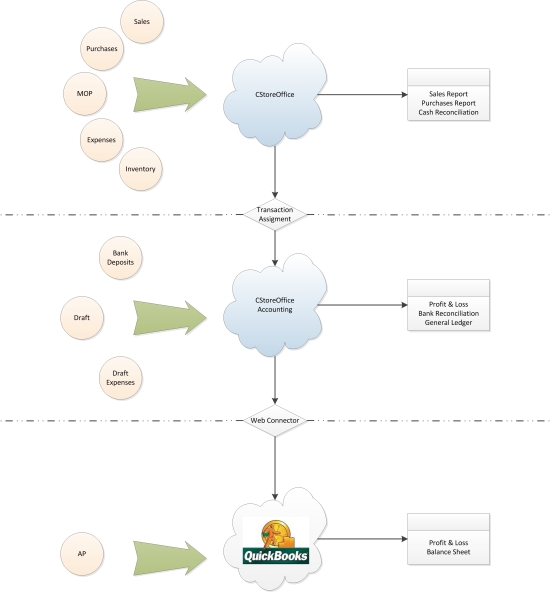Before you start using QuickBooks, make sure the following prerequisites are met:
- QuickBooks is installed on your computer. CStoreOffice® is compatible with the following QuickBooks versions:
- QuickBooks® 2007
- QuickBooks® 2008
- QuickBooks® 2013
- QuickBooks® 2016
- QuickBooks® 2017
- QuickBooks® 2018
- QuickBooks® 2019
- Your computer is connected to the Internet.
- Your user has the administrator rights. Administrator rights in QuickBooks (hereafter referred to as QB) are required to perform the connection setup and to access the synchronization programs for QB.
- The Accounting module in CStoreOffice® is configured properly.
Main Workflow Overview
The following flow is recommended for working with QB in CStoreOffice®:
| Step | Step description |
|---|---|
| Step 1: Enter data into CStoreOffice® | Enter your sales, purchases, MOPs, expenses, and inventory into CStoreOffice® using one of the following ways: - Manual entry - EDI - Data operator entry - Inventory groups |
| Step 2: Reconcile data in CStoreOffice® | Edit your data entry to reconcile all information coming into CStoreOffice®, and see your sales and purchases reports. |
| Step 3: Choose your account settings | Choose one of the following types of account settings: - CStoreOffice® common account settings - CStoreOffice® advanced account settings - Previously established QB Chart of Accounts |
| Step 4: Synchronize with QB | Synchronize with QB using QB Web Connector to establish initial connection and populate the chart of accounts. |
| Step 5: Set up transaction assignments | Once you have populated your Chart of Accounts, set up your transaction assignments for your accounts credits and debits to ensure that the QB data match the CStoreOffice® data. |
| Step 6: Complete and close audit periods. | Complete audit periods of your specified time frame for your location and close the audit period to lock the data from future changes for the time frame you are auditing. |
| Step 7: Synchronize with QB once again | Send your data to the synchronization manager and synchronize them with QB once again to populate QB accounts with the data from CStoreOffice®. View QB P&L Sheet to verify proper transaction assignments for the data types. |


